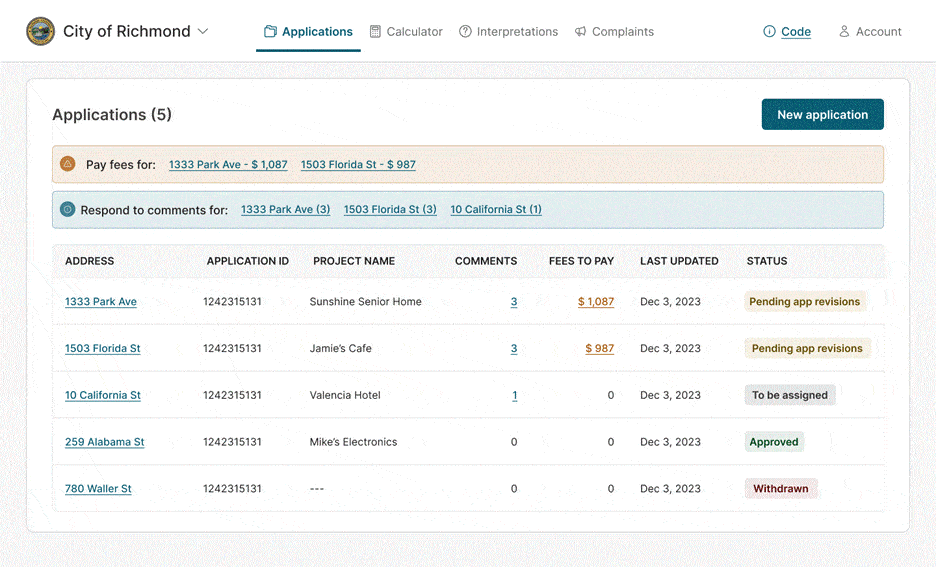Infilla Leverages AI to Accelerate Permitting for New Housing Developments
New Company Aims to Streamline the Permitting Process for Localities Across the Country

By Michael Murney
5 min read
After interviewing hundreds of real estate developers, architects, and planners, Jenny Song came to a simple conclusion: local governments’ entitlements and permitting systems are broken.
Song, a career technologist and longtime San Franciscan, found that planning departments across the U.S. are using outdated and poorly built software to track permitting and entitlements for new developments. Delays and inefficiencies caused by bad software drive up costs for local developers.

Infilla, the company Song launched in January 2024, aims to solve this problem by creating a “one-stop shop for permits,” she says.
“Basically, there’s never been software built for planning departments. So, we imagined, ‘what if permitting worked? What would that look like?'” says Song.
“Square Peg Round Hole” Software Spikes Costs, Causes Delays
During interviews with 100 real estate developers and architects, Song says she heard repeatedly that problems with permitting and entitlement systems were hurting their bottom lines and delaying the building process.
When she shadowed local government planners, Song found they all tracked projects using software packages designed to track permits.
“[The software] was built to track permits, but it doesn’t do all the things that planners need today,” Song explains. “[Do] you need to figure out how many housing units are being built? It wasn’t built to support that. Was it built to support entitlements? Not really. Was it built for code enforcement? Not really. So, the underlying architecture doesn’t make sense. Planning departments have square-pegged, round-holed themselves into this.”
Using ill-equipped software causes significant delays in the application review process. For example, according to Song, around ten percent of applications submitted to local planning departments are incomplete upon submission. “This means there’s a lot of back and forth between applicants and staff.”
This back-and-forth period, which must be completed before planners can begin to review the application, is drawn out by inefficiencies inherent to the planning department’s software. “[Planners] told me how difficult data was to get for them and how hard it was to figure out how many units are associated with a project,” says Song.
These delays translate into major costs for applicants.
“If you’re a real estate developer, holding land, then you’re holding property, you’re paying mortgage interest, and then the process actually starts, and then you don’t know when it’s going to finish. And that adds to costs,” Song says.
Indeed, according to a March 2025 report from LAI Design Group, each month of delay due to regulatory hurdles can add between one and three percent of total project value, resulting in potentially millions of dollars in extra expense.
Song explains that inefficient municipal planning software particularly plagues the impact fee assessment process, which is especially complex. This can cause last-minute, sometimes unanticipated, additional developer fees just before groundbreaking.
Song says many of these issues would be solved by making permitting processes more predictable. “The big term that a lot of real estate developers talk about is…predictable permitting. Our ambition is to make predictable permitting happen,” she says.
An AI-Powered “One-Stop Shop” for Permitting and Planning
Song says Infilla’s goal is to eliminate these inefficiencies by providing planners with a new tool designed specifically for them and using AI to implement it quickly.
This means replacing the department’s existing software, which Song says was built poorly initially. “I talk about gilding the turd a lot. …If your underlying software is terrible, all you can do is gild it. The foundation was built incorrectly, so it’s not going to get much better with existing legacy software,” she says.
Song explains that the core of Infilla’s product is ” good, solid software. It’s built with the right underlying architecture.”
Song and the Infilla team use artificial intelligence to accelerate their software engineering process and implementation. While some existing planning software was built over ten years, Song and her team can build packages for local departments within a year, she says.
While Infilla’s product takes about a year to implement, Song and her team install its software modularly, gradually introducing client departments to the platform and allowing planners to use certain product features before it is entirely in place.
Perhaps most importantly, Infilla’s user interface organizes information by project instead of by permit, “which is the way people actually think,” Song says.
Song ultimately hopes to streamline the building process for government and private sector stakeholders by providing planners with an intuitive interface built on solid engineering. Her vision is already coming to fruition, with several of the largest local departments in the U.S.—including the New York City Department of Buildings and the San Francisco Planning Department—already on her client list.
Advertisement
Infilla software is already yielding significant improvements within client departments; in Sonoma County, for example, Song and her team helped eliminate a two- to three-month backlog of a specific permit type while saving staff 30 hours per week of intake labor by implementing one of their products.
“Real estate developers and architects, as well as people on the government side…want to build really great infrastructure or buildings for people. They’ve just been frustrated by using the same tools that don’t help the government or the private sector,” says Song. “So, if we can do this and make the lives of everyone at the table easier, then perhaps it doesn’t have to be so expensive to build.”



